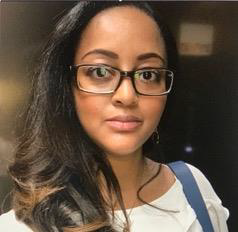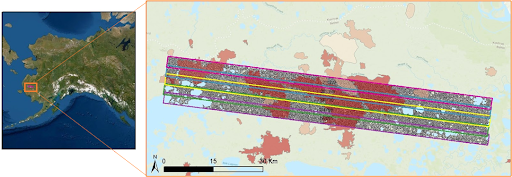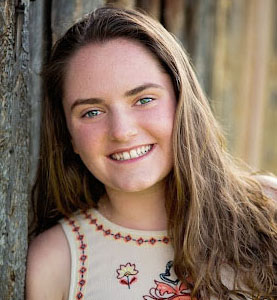|
|||||||||||||||||
Leadership Update
|
|||||||||||||||||
|
As you all know, 2021 was another challenging year due to the pandemic and the emergence of new variant strains, travel restrictions, juggling the challenges of in-person work, teaching, meetings, school openings and closings, and all the other day to day routines that have been upended. Fortunately, years of impressive science have led to effective vaccinations that provide protection against severe illness and hospitalizations. We hope that all of you, your families, friends and loved ones have fared well and been able to overcome the challenges. In terms of ABoVE research, it is clear that we have been able to move forward despite the COVID challenges. More than 70 peer-reviewed ABoVE publications came out in 2021, including Nature, Nature Climate Change, Proceedings of the National Academy of Sciences, Global Change Biology, and 16 more papers in the ABoVE Focus Collection of Environmental Research Letters (which now includes 58 invited and contributed papers). In addition, there were over 25 new data sets archived at the ORNL DAAC, substantial advances on various working group synthesis activities, some 40 presentations in 4 oral sessions at the 2021 annual AGU Fall Meeting coupled with dozens of eLightning and poster presentations, 6 webinars held as part of our Yukon and Northwest Territories speaker series, plus many other advances both at the program coordination and the individual project level. Although we had to cancel ABoVE airborne campaigns and most fieldwork again in 2021, we have been actively planning to conduct campaigns during July-August 2022 and to coordinate with a SnowEx campaign being planned for Fall 2022 and Spring 2023. We are also planning an in-person (or hybrid) Science Team Meeting in Fairbanks the week of May 9th (ASTM8) culminating in a 1.5 day “research to operations” workshop coordinated with the Alaska Fire Science Consortium. Many of you may recall that we had similar plans last year that had to be postponed, but we are hopeful that this time we will be able to follow through. We understand if some of you may be hesitant to commit to travel to an in-person meeting, but we hope you will consider it given the value and benefits of personal interaction and the inherent joys of meeting and catching up with our colleagues again if conditions permit. We recognize too that some of you will have Phase-2 support coming to an end this Spring and that Phase 3 projects may not start until late fall or early winter. Nonetheless, we hope those of you in this situation will have travel funds you were unable to use and can request a no-cost extension or find some other way to attend. Note that the International Circumpolar Remote Sensing Symposium (ICRSS) is planned for the week of May 16th in Fairbanks (in person only), which we hope you will consider attending as well. As always, we appreciate what each of you have done and continue to contribute to our collective effort to better understand the vulnerability and resilience of northern ecosystems. Until we meet again in person, we hope to see you online at one of our webinar series, working group, airborne / field campaign, ASTM8 planning, or some other virtual meeting. We hope that 2022 will be another productive year for ABoVE and for you! - Scott, Chip, Peter, Libby, Liz, Dan, Mike and Hank |
|||||||||||||||||
Airborne Campaign and Associated Field Work in 2022
|
|||||||||||||||||
|
We are beginning to assess the prospects for L-Band SAR and AVIRIS flights in Alaska and Canada to be conducted during the months of July and August. We are currently reaching out to the NASA-funded investigators and their collaborators to better understand their plans and concerns. We still have the 2020 plan in hand and will modify it as necessary to accommodate 2022 changes. The requirements for field work in both Alaska and Canada remain very fluid. We will keep everyone informed as our understanding of the overall situation improves. In other words, Stay Tuned! |
|||||||||||||||||
ABoVE Science Team Meeting in 2022
|
|||||||||||||||||
|
|||||||||||||||||
Stakeholder Engagement
|
|||||||||||||||||
|
This past summer, we had an intern conducting research on ABoVE partner and community engagement, Ryan Naylor. Ryan is a graduate student at Penn State University in the Dept. of Recreation, Park, and Tourism Management. Ryan’s project had two objectives: identify the research needs/interests of the communities, organizations, and institutions that ABoVE already engages with; and identify new groups for future ABoVE engagement. He sent a survey sent to all ABoVE participants, asking which research themes and activities were most relevant to their work, and to also identify potential new partners and collaborators we may not already be in contact with. He compared this information with data about who has downloaded ABoVE data products from the ORNL DAAC. Ryan was able to identify 41 new organizations not currently listed in either the ABoVE or DAAC databases that may have interest in ABoVE. Ryan and Libby Larson created a poster that Peter Griffith presented at the 2021 AGU Fall Meeting: SY55B-0355: Discovering the research needs of current and potential partners and collaborators for NASA's Arctic Boreal Vulnerability Experiment (ABoVE). He also made recommendations for future engagement activities for new and existing partners, and looking forward we anticipate hiring another intern this summer to further this work (see ABoVE Intership section below). In the meantime, we will continue with our regional occasional webinar series for Alaska, Yukon, and Northwest Territories. These webinars serve as a venue to share data and information about ABoVE research with the broader community, and for all to learn about other research and activities in the state/territory/region. These webinars have been successful in helping members of the ABoVE community maintain connections with stakeholders and other researchers, especially given the challenges of the global pandemic. We are always looking for new presenters, whether directly associated with ABoVE or from our Canadian/tribal colleagues. If you are interested in presenting, please contact Libby Larson. |
|||||||||||||||||
ABoVE at AGU
|
|||||||||||||||||
|
Many thanks to all who participated, virtually and in person, in the AGU Fall Meeting in New Orleans. ABoVE research was presented in many sessions, one of which “The Resilience and Vulnerability of Arctic and Boreal Ecosystems to Climate Change,” was convened by Abhishek Chatterjee, Peter Griffith, Michelle Mack, and Natalie Boelman. Once again one of the largest in the Biogeosciences section, it had four oral sessions, one eLightning session, and one poster session. AGU members can view the talks and posters until February 28, 2022 at #AGU21 On Demand. ABoVE was also featured on the NASA Hyperwall in the Exhibition Hall to an enthusiastic audience that included the Oak Ridge High School students who built the recently-launched RAMSAT cubesat. Many thanks to those who contributed science highlights and animations to the presentation. 
|
|||||||||||||||||
ABoVE 2022 Summer Internships
|
|||||||||||||||||
|
Students consider applying! There are two NASA-sponsored Summer Internships being offered through ABoVE: Currently these internships are planned to be virtual opportunities. Students will be mentored by Liz Hoy or Libby Larson from the NASA Carbon Cycle and Ecosystems Office, with projects selected to benefit the Science Team and developed with the student. Note that these internship opportunities are available only to US Citizens enrolled as students at an academic institution. |
|||||||||||||||||
Early Career Spotlight
|
|||||||||||||||||
|
The influence of Arctic tundra fires on methane hotspot distribution in Alaska  Elizabeth (Elsa) Yoseph worked as a summer intern for ABoVE during 2020, and continued her research during the school year - all while attending dual graduate programs in climate science and policy at Bard College and law at Vermont Law School. Her research uses methane hotspot data derived from the AVIRIS-NG airborne sensor, which was flown over the Yukon-Kuskokwim Delta region of Alaska in 2018. Ms.Yoseph found that tundra fires are correlated with an increase in methane hotspots in the region. These enhanced methane emissions following tundra fire represent a positive feedback to climate warming, fire occurrence, and future permafrost carbon loss.  Figure: Location of research with AVIRIS-NG flight lines and burned area polygons. Active layer thickness as a function of soil water content  Leah Clayton is an undergraduate student majoring in Earth and Planetary Sciences at Yale University, planning to graduate in May of 2024. During the summer of 2021 she was an intern for ABoVE, however she has worked with Dr. Kevin Schaefer since 2019. Last year Ms.Clayton authored a publication discussing the field measurements of soil moisture and active layer thickness gathered in support of ABoVE. Approximately 350,000 observations from over 100 sites were collected by multiple researchers from 2009 to 2019. This dataset can be compared with the airborne SAR imagery collected as part of ABoVE. Using this dataset it was found that increased soil moisture at the surface increases thermal conductivity and the exchange of energy with the atmosphere, resulting in deeper active layers. 
Figure: Sites from the new active layer thickness dataset. This dataset is now at the ORNL DAAC as a freely available and downloadable product: The changing carbon balance of tundra ecosystems: results from a vertically-resolved peatland biosphere model Dr. Erik Larson completed his PhD in Atmospheric and Oceanic Sciences at the University of Colorado Boulder in 2014. In his recent work, funded by an ABoVE research project under Dr.Bill Munger, the team implemented and analyzed a model of peatland soil carbon within a terrestrial biosphere model to improve understanding of how on-going changes in climate are altering the Arctic carbon Budget. Three Alaskan tundra eddy covariance tower sites were used in the research, which showed that the zero-curtain phenomenon is critical to capturing observed patterns of wintertime respiration. Additionally, they found significant declines in net ecosystem productivity (NEP) starting in 2013 and that these declines are driven by increased heterotrophic respiration arising from increased precipitation and warming.  Figure: Simulated soil temperature at Imnavait Creek tower sites. The zero- and one-degree contours are shown.
If you are an Early Career Scientist or have a student with recent research that could be highlighted in our newsletter, please send information to Liz Hoy at elizabeth.hoy@nasa.gov. |
|||||||||||||||||
Published ABoVE Data
|
|||||||||||||||||
|
Published ABoVE data archived at ORNL DAAC have been accessed 37,430 times by a total of 8,897 unique users (identified by IP address) since January 2015. A total of 144 field, airborne, and modeled data products from ABoVE research are now available from the ORNL DAAC. ABoVE datasets have been cited 74 times by other publications thus far in the campaign. Browse ABoVE data at the ORNL DAAC. As a reminder, the LVIS data collected for ABoVE are available from the NSIDC DAAC and UAVSAR data are archived at the Alaska Satellite Facility.
ABoVE: Fractional Open Water Cover for Pan-Arctic and ABoVE-Domain Regions, 2002-2015
1,293 downloads
| |||||||||||||||||
NASA Stories and Media Coverage
|
|||||||||||||||||
|
ABoVE has been getting a lot of attention in the Media and NASA's news team. Check out what has been covered!
|
|||||||||||||||||
ABoVE Jobs
|
|||||||||||||||||
|
Multiple job openings with ABoVE Projects. If you would like to post a position, email support@cce.nasa.gov.
|
